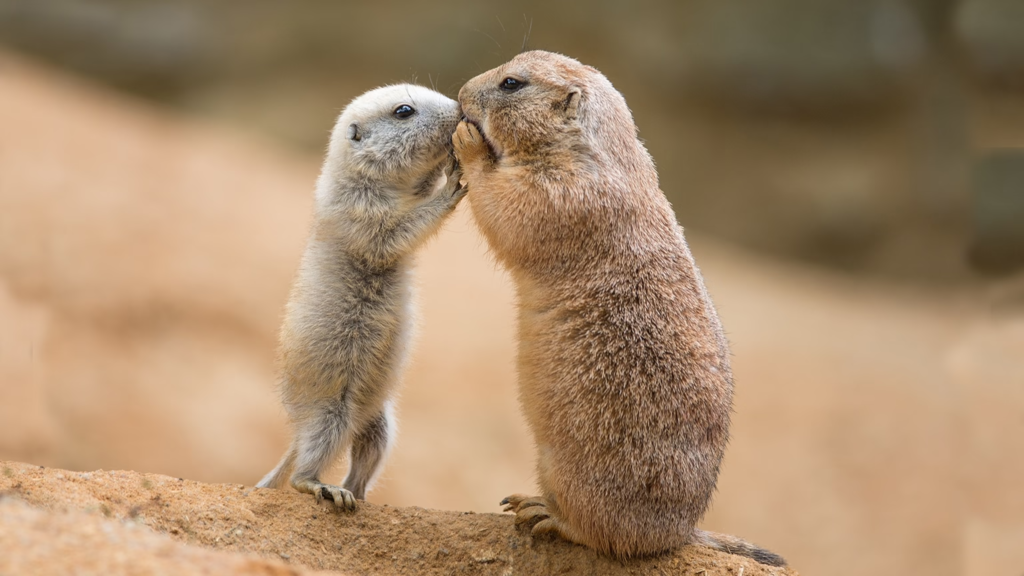Last Updated on September 30, 2023 by Fumipets
Do Prairie Dogs Make Good Pets? What You Need to Know!
Prairie dogs, with their charming and social nature, may seem like appealing pets to some. However, before considering them as potential companions, it’s crucial to understand the complexities of keeping prairie dogs as pets.
Here’s a summary of the key factors to consider, along with five common questions and answers about having prairie dogs as pets:
Prairie Dogs as Pets:
- Considerations: Prairie dogs are wild animals, and their suitability as pets is a matter of debate. They require specialized care, a controlled environment, and adherence to legal regulations in some areas.
- Social Creatures: Prairie dogs are highly social animals that thrive in the company of their own kind. Keeping them alone may lead to loneliness and stress.
- Space and Housing: Prairie dogs need a spacious enclosure that mimics their natural habitat. Burrows, hiding spots, and climbing opportunities should be provided.
Although being referred to as “dogs,” prairie dogs are really big rodents that are indigenous to the U.S. Great Plains. Black-tailed prairie dogs in particular are becoming more and more popular as pets, but are they suitable for confinement?
Owning a prairie dog as a pet has a number of difficulties, particularly when it comes to giving it the care it requires and providing it with a natural home. Learn all you need to know about what it involves to maintain one of these creatures and decide whether it’s a suitable match for you.
About Prairie Dogs
In grassland environments, prairie dogs are burrowing, herbivorous rodents. The Utah, Mexico, Mexican-tailed, Black-tailed, White-tailed, and Gunnison’s prairie dogs are the five species of prairie dogs found in North America.
The prairie dog is a keystone species in the wild, which means they have a significant impact on the surrounding ecosystem. Their mound-building efforts promote topsoil replenishment and grass growth. They contribute to the food chain by serving as a species of prey for predators including foxes, ferrets, coyotes, hawks, and golden eagles. Other burrowing rodents, birds, and grazing animals all use prairie dog tunnels as a source of food and a place to build their nests.
Are Prairie Dogs Legal to Own as Pets?
One of the rodents linked to the 2003 monkeypox epidemic that resulted in a five-year ban on the pet trade was the prairie dog. The FDA loosened its prohibitions on prairie dogs being sold as pets in 2008. But, in 2016, a rising worry that prairie dogs may spread the plague prompted several governments or cities to impose ownership restrictions. When obtaining a prairie dog, like with any unusual pet, be careful to verify your local regulations.

Behavior and Temperament
In the animal realm, prairie dogs have some of the most advanced social systems and communication. In order to avoid boredom and stress, prairie dogs need a lot of socializing and care. If you are unable to spend at least 6 hours a day with your prairie dog, you will need to provide them access to a large colony in order to satisfy their social demands.
Since they are diurnal, they are active throughout the day. This helps with socializing, but you’ll need to find a pet sitter or buy a colony to take care of their requirements while you’re out at work all day. If you don’t handle your prairie dog often, it can get hostile.
Male vs. Female Prairie Dogs
Good temperaments are possible in both male and female prairie dogs. Compared to females, guys have a musky smell, but it’s not unpleasant. Regardless of your decision, your prairie dog has to be spayed or neutered in order to avoid health problems and reduce hormonal hostility.
Both intact or spayed females and fixed males may live together in the same enclosure. Males must be neutered to avoid mating if you want to keep them with females. Only fixed animals should be present in whole colonies.
Prairie Dog Housing
A realistic environment that permits digging and foraging is required for prairie dogs. You will need a room-sized cage with concrete boundaries and at least three feet of underground digging area since adult prairie dogs may tunnel several feet and form chambers. Inability to burrow may cause worry and anxiety in your prairie dog.
Outside fences are appropriate in certain climates. While prairie dogs don’t hibernate, they do burrow and become inactive in the colder months. But if you don’t provide them with a burrow, they can’t handle the scorching summers and freezing winters that come with living outside.

Prairie Dog Diet
Prairie dogs mostly consume grasses in the wild, and they drink water from prickly pear cacti. They forage as well, so they consume roots and bushes. Dietary staples for captive prairie dogs include pellets, hay, grasses, seeds, nuts, and vegetables. Getting adequate fiber is crucial for a healthy digestive system. There are several commercial prairie dog feeds on the market that satisfies their dietary needs.
Prairie Dog Health Problems
Be sure you have access to an experienced exotic veterinarian in your neighborhood or within driving distance before purchasing a prairie dog. Since prairie dogs may be combative and violent during exams, the majority of veterinarians sedate them using gas anesthesia. Prairie dogs should have at least one yearly examination and a six-month checkup during their whole lifespan. You may need to increase their tests as they become older to two or three times a year.
A fecal check for parasites, a thorough physical examination, blood tests, urine tests, and radiographs are often included in exams. At present moment, vaccines for prairie dogs are neither required nor recommended.
In captivity, prairie dogs are more likely to have health issues including obesity and respiratory or cardiovascular diseases. Dental issues are also rather typical. With the proper food, exercise, and regular veterinarian checks, all of these may be avoided.
Monkeypox, which was detected in prairie dogs in 2003, is still another issue. Eye and nasal discharge, swollen lymph nodes, fever, and skin lesions are all signs of this illness. A zoonotic illness called monkeypox may spread to people.
Where to Buy or Adopt Prairie Dogs
During the pupping season, which runs from April through July, prairie dogs are for sale. Many thousands of puppies are gathered to reduce the number of prairie dogs in the wild due to their overabundance. Upon collection, USDA-approved dealers either sell them into the pet trade or utilize them as food for endangered animals.
The best and most trainable prairie dogs are those that are young. It is advisable to have a lot of babies to raise and house together if you want to build a whole colony. The healthiest alternative is for young prairie dogs to connect with their colony rather than their human owners.
Although relatively new to the pet sector, prairie dogs may not be available for adoption. Also, adaptable ones could have behavioral or health issues. Have your prairie dog examined by a veterinarian to make sure it’s healthy, whether you’re adopting or buying one.
Conclusion
For devoted owners who provide their housing, nutritional, and social requirements, prairie dogs may make excellent pets. Nevertheless, owning a prairie dog requires a lot of attention and money, so it may not be the best choice for those who are busy or for families with small children and other pets. Prairie dogs may also be zoonotic carriers of illnesses that affect both their owners and the broader population, as well as develop behavioral problems.
https://www.youtube.com/watch?v=q05A6WJZ6ng
Prairie Dogs as Pets: Common Questions and Answers
Are prairie dogs legal as pets everywhere?
No, laws regarding prairie dogs as pets vary by location. Some states and municipalities prohibit their ownership due to concerns about zoonotic diseases and ecological impact.
Can prairie dogs be potty trained?
Prairie dogs cannot be reliably potty trained, and their cages require regular cleaning.
Are prairie dogs prone to health issues?
Yes, prairie dogs can be susceptible to a range of health problems, including dental issues, obesity, and respiratory infections. Regular veterinary care is essential.
Can I provide companionship for a single prairie dog?
Prairie dogs are social animals, and it’s generally recommended to keep them in pairs or small groups to prevent loneliness and stress.
What do prairie dogs eat, and can I meet their dietary needs?
Prairie dogs have specific dietary requirements, including fresh vegetables, hay, and commercial prairie dog pellets. Meeting their nutritional needs can be complex and costly.


















